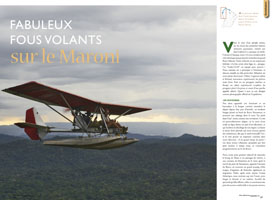This is a story of an airborne voyage, following in the footsteps of the earliest flights in French Guinea nearly a century ago, the first of which were performed by Jean Galmot. Our flight will take us, as it did then, from the Atlantic coast to the meanders of the great River Maroni. Our craft is a surprising hybrid, both a ULM and a pirogue. This “hydro-ULM” can land on water! Six of us set off on this adventure, and we each have a specific role. Sébastien is our veteran pilot, Didier is the apprentice pilot and Roland, an experienced instructor, will be lending him a helping hand. Feni is expert with a pirogue, and Koupé an experienced takari (the person sitting at the front of the pirogue who helps steer it using a pole called a takari). My role is to act as the expedition’s official photographer.
1 November
Our two craft (a hurricane and a baroudeur with a long career behind it) are waiting to set off from their home port, a modest hangar standing on the edge of the River Sinnamary, just next to an invitingly named inn, “Les pieds dans l’eau” (literally, dipping your feet in the water). It is a particularly suitable site as the water flows in a straight line for nearly a kilometre, making it easier for our craft to take off. The tall dense rainforest all around us generates turbulence as soon as the sun starts to heat the air, and the wind is driving towering cumulus in our direction. It is high time we were off! The two planes gather speed, driven along by their little two-stroke Rotax engines, and we gradually rise up from the riverbed.
We are aiming to get to the little town of Mana set amongst the paddy fields about 100 kilometres away. Just after flying over the bridge at Sinnamary, we catch sight of the estuary of the river where there are great flocks of red ibis, cormorant, and waders who, like us, are on their way through. Finally, once we have reached the Atlantic Ocean, we head west along the coast and its mudflats. In addition to offering a fine view, they can also double up as a comfortable emergency runway should an engine fail, the nightmare of all ULM pilots. Then it is mangrove forests, a form of vegetation which is typical to the Guianese coast, with mangrove trees stretching out in all directions as far as the eye can see. Finally the town of Mana appears amongst its landscape of paddy fields, a vast rectangular area of changing colours where we look somewhat anxiously for a little canal where we can land amidst the labyrinth. After flying past a few times we are relieved to be able to set down on a long stretch of water.
This countryside of paddy fields is also the haunt of a seasoned pilot of west Guiana, Eric, who cut his teeth spraying the rice crops from his hydro-ULM. He and his family welcome us for a friendly stopover and an evening spent reminiscing about the exploits of the first ULM pilots in Guiana, twenty or so years ago.
2 November
After breakfast, during which our hosts regale us with an amazing jam made from the flowers of the Ipe (a tree with easily recognisable yellow flowers), we are ready to set off for the Maroni. We take off from the canal without a hitch and our two craft join up in the air to head for the western border with Surinam. In the pale light of dawn we fly over the coastal savannah with its strange patterns created by the ancestral Amerindian agricultural technique of raised fields. We leave the Amerindian villages of Awala-Yalimapo to our south, a place which is known worldwide for the leatherback turtles which come and lay their eggs there, and then we head up the immense Maroni estuary. In Saint-Laurent we are joined by our last two travelling companions, Koupé the takari and our pirogue helmsman Feni. We will be continuing our expedition on their boat. We come alongside the brand-new pontoon facing the neighbourhood of Charbonnière, and temporarily tie up our craft there. The arrival of our strange flying machines does not fail to awaken the curiosity of the local children, and we have to step in when a dozen or so young swimmers come up with the idea of using our ULMs as diving boards. In the meanwhile our new guides have arrived. Duly laden down with fuel and food, and once the introductions are out of the way, the crew is ready to embark on the journey up to the sources of the river.
We encounter our first mishap during the following leg near the village of Boni d’Apatou. Whilst looking for a suitable place to have lunch we are taxiing along behind the pirogue in our hydro-ULMs, and gradually get further and further into a narrow stretch of the river, which, more importantly, becomes more and more torrential. We realise that we are going up the Saut d’Apatou (where there is a change in height in the riverbed) on our floats, and only a dangerous manoeuvre to turn around amidst the rocks and raging current gets us out of this fix at the last minute! For our first night on the banks of the Maroni, we set up our hammocks in a little Amerindian “campou” called Nasson, comprised of a few huts lying on the Surinamese bank of the river.
3 November
Favourable weather conditions mean we fly without incident as far as the village of Providence, beautifully scattered over the paradisiacal islands on this stretch of the river. In the late afternoon we improvise a “mini air meet” for the inhabitants. The most intrepid amongst them go up for their first flight, a unique opportunity to discover the village as seen from the air. Then, before cracking open a Parbo, the traditional Surinamese beer, it is time to check our material and carry out some maintenance, as on a ULM the only mechanic is the pilot himself.
4 November
Today we are going to be reaching the southernmost point on our journey. Before setting off for Mofina, the village where the family of Feni, our skilful young pirogue helmsman, lives, our craft halt at the village of Grand Santi. Once night has fallen Feni takes us to an impromptu party complete with massive sound system on a little island, and on the way there gives us an impressive demonstration of skippering blind in the Abattiscottica rapids.
We spend a few peaceful days in Mofina, lying on a peaceful narrow arm of the Maroni. We take advantage of this moment of respite to talk with the Djukas, and meet some schoolteachers sent to this isolated region who would not change their posting for anything in the world. It is so pleasant there that we would happily prolong our stay.
But we need to complete our journey and think about going back down the river.




 English
English Français
Français  Português
Português 
















 Télécharger l'article en PDF est réservé aux abonnés Web !
Télécharger l'article en PDF est réservé aux abonnés Web ! 
 Pas de réaction
Pas de réaction Comment!
Comment!


 Voyages avec Tooy. Histoire, mémoire, imaginaire des Amériques noires : Editions Vents d’ailleurs, 2010
Voyages avec Tooy. Histoire, mémoire, imaginaire des Amériques noires : Editions Vents d’ailleurs, 2010
 Guyane. Produits du terroir et recettes traditionnelles. L’inventaire du patrimoine culinaire de la France : Editions Albin Michel, 1999
Guyane. Produits du terroir et recettes traditionnelles. L’inventaire du patrimoine culinaire de la France : Editions Albin Michel, 1999
 Alunawalé, un voyage à travers les milieux naturels de Guyane : Office National des Forêts, 2009
Alunawalé, un voyage à travers les milieux naturels de Guyane : Office National des Forêts, 2009
 Augusta Curiel, Fotografe in Suiriname 1904 – 1937 : Libri Misei Surinamensis, 2007
Augusta Curiel, Fotografe in Suiriname 1904 – 1937 : Libri Misei Surinamensis, 2007


